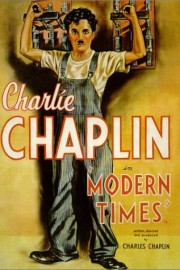Modern Times
Although Charlie Chaplin made his masterpiece, “City Lights,” four years into the sound era, that film was still, resolutely, a silent film, despite the presence of sound effects and a pre-recorded score. Five years later, Chaplin made “Modern Times,” which included the first use of recorded dialogue the filmmaker used in one of his features. However, Chaplin still didn’t give in entirely to the use of sound– spoken dialogue is limited to a factory at the beginning; when the film follows Chaplin’s Little Tramp, the film could have easily been made a decade earlier.
Watching it for the first time in a while, I couldn’t help but wonder if the film is as much about Chaplin’s yearning for the silent era (when he was one of the undisputed kings of cinema) as it is about the modern, industrial age he found himself in at the time. The film has Chaplin’s Little Tramp struggling to hold down a factory job at the beginning. It isn’t long before he finds himself in prison, where he seems oddly at home. When he’s let out, he inadvertently finds himself leading a union rally in the streets, after which he finds himself in jail. He is released, with a letter of recommendation from the warden, but he keeps finding himself in prison. Or is it on purpose? When he takes responsibility after a young, homeless woman (Paulette Goddard) steals a loaf of bread, it’s easy to see that maybe he feels more comfortable than he does on the streets. Taken in these terms, the industrial society outside of jail is the sound era of cinema, and jail is the time before 1927, when films relied on images, and a live soundtrack, to tell their stories. Considering how much freer filmmakers became after the introduction of sound, though, it’d be easy to see how the silent era, and lack of sound, could be considered a prison for directors who wanted to expand the art form, and did so after “The Jazz Singer” opened the gates to do so.
Back to “Modern Times,” though. Regardless of who much sound, or how little, is on soundtrack, it is a wonderful cinematic treasure chest from Chaplin. I will always prefer Buster Keaton over Chaplin, but the iconic vaudeville performer infuses his films with wonderful energy and sentiment. And here, there are great set pieces, including the famous moments when the Tramp (and later, his foreman), working at the factory, gets pulled into the gears of the machine he is working on the assembly line of. Even more entertaining is when he and Goddard’s character (known in the film as “A Gamin”) spend the night in a department store where the Tramp is now a security guard. He is roller skating on one of the upper levels of the store, and is barely missing a large opening in the railing. It’s a simple pleasure of a scene that makes Chaplin’s brand of humor so much fun to watch. With each job he goes to (and when he and “A Gamin” find a beaten-down shack to live in), which is immediately followed by a stint in prison, he finds himself in situations which are comedically rich, and filled with possibilities. Each time, though, something seems to go wrong, giving the Tramp the feeling that maybe the modern world isn’t for him. “Modern Times,” however, represents a filmmaker trying to come to terms with the world he lives in, and finds many sources of inspiration that will only enrich his art in the long run.










